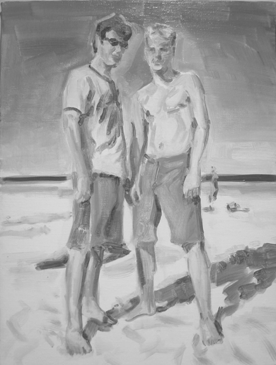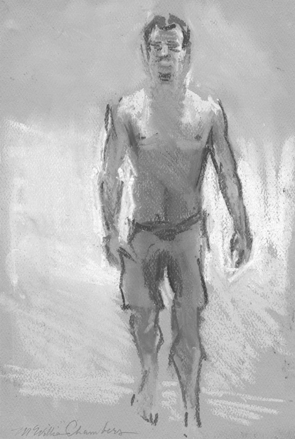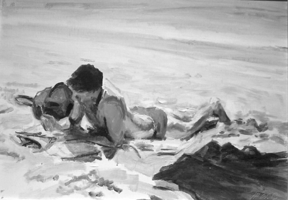Lucid Dreaming
[]
Why is it that we’re so interested in artists’ lives? No one seems to care what an accountant or a sanitation worker does in his or her extracurricular pursuits, whether or not they’re married or divorced, or have kids, or how they decorate their homes. But when we talk about artists—well, everything seems to grow in significance.
There’s a theory that even Warhol’s Campbell Soup can paintings were autobiographical, because apparently he had a can nearly every day for lunch. So far as I can tell, this is more interesting in terms of explaining his notorious cheapskate streak than explaining the paintings, but it serves as testament to the deep-seated need we have to explain cultural, creative objects in terms of the life of their creators. Even the esteemed John Richardson saw fit to promote the view that Picasso’s art is at any one time a function of the changes in five private forces—his mistress, his house, his poet, his set of admirers, and his dog (sic!).
Such explanations seem to spring out of common assumptions of what art is about—most often these are sprung on some unarticulated notion that before it is anything else, art is (personal) expression, pure and simple. (Of course, the whole concept of expression itself is anything but pure and simple, but let’s not trouble ourselves with all that!)
The element that tends to fall away from (or at least trail behind) in such accounts is the degree to which humans are fundamentally social beings: Without the possibility of having others look at or engage with the work, why would anyone bother making art? (Of course I am exempting here those special cases of “outsider” artists who obsessively construct their alternate universes, often over a lifetime, with no expectation—and sometimes even with hostility to—the idea that others will get to see their art. They are the exception that proves the rule, in this case.) Just as it is impossible for there to be a language spoken by only one person, there can be no culture without the presence of at least a few other people to witness it.
Once you allow for this social dimension, you open up the possibility for politics of course—creating another role for art, especially when it focuses on the needs and interests of the oppressed (as opposed to the dead-white-Euro-male tradition, which proved very effective at shoring up its own power base through art). Using art in this fundamentally political way is perhaps most clearly illustrated in the feminist work that emerged in the late 1960s and early ’70s.
By the 1990s, the personal-is-political crowd had evolved into a virtual smorgasbord of multicultural interest groups, each advancing its own agenda in the name of “identity politics.” Far be it from me to question the wisdom of sticking it to the status quo (why else would I be writing for Chronogram?), but there’s something lost in the process of looking at art as nothing but a stage for (alternative) political posturing as well.
A show this month of work by McWillie Chambers (what a great name!) at John Davis Gallery in Hudson is what sparked these ruminations. Chambers’s small-to-medium-sized paintings focus on the human figure, executed in a loose, sketchy style, often emphasizing dazzling patches of color and light. The fact that the artist is gay, and that most of his figures are male (often lounging about either all or half naked on the beach) has caused many critics to play the “gay identity card” in response to the work, but that denies or denigrates everything about it that is not reducible to the political—the fact of the matter is, Chambers is a damn good artist, and his paintings richly reward close aesthetic appreciation, transcending the abstract pieties imposed on it when it’s oversimplified as “queer art.”
The truth of the matter is that art functions both ways—from the pole of the personal, the individual, it shuttles out to its audience, to the world of the political, and then returns yet again to the private, the place where each viewer engages it, understands it (or not), and in the process helps to re/define its meaning. There is room for personal expression, and there is room for politics here: These two apparent opposites are in fact joined at the hip. Without the social dimension, the idea of the “personal” makes no sense, and without the privacy of personal experience, moving out to take part in the broader social or cultural world would be impossible.
Chambers’s approach to the figure actually reminds me quite a bit of the work of Leslie Bender, whose show at Albert Shahinian Gallery in Poughkeepsie last month just closed. Bender has a similar sensibility for kaleidoscopic color, for use of the figure (although hers are often, but not exclusively, female), and for a seductively sketchy yet spot-on contour line. I’ll admit that I’ve never spoken to Bender about her sexual orientation, but then, it never seemed to be the major issue at hand in her work, either. Such an aesthetic commonality points to something beyond identity as the key to understanding both artists—they both work in the same region, are acquainted with the same artistic scene, are inheritors of many of the same aesthetic ideas. So why ignore such obvious correspondences, in favor of lumping Chambers in some dubious queer canon, along with Paul Cadmus and Pavel Tchelitchew?
This is a question posed by artist Bill Sullivan, who wrote about Chambers for a show he had in New York a few years ago. Sullivan calls out the absurdity of reducing the work to such a reading, asserting that, “if he painted apples would he be in the tradition of Cezanne?…The self-absorbed narcissism of gay culture and its clichés keep us from Chambers’s paintings.”
As they say, the road to hell is paved with good intentions. As important as it is to fight oppression, raise consciousness, and otherwise tear things up, we can’t forget to stay open and responsive, especially when it comes to art—a lesson that McWillie Chambers’s paintings can teach us well.














